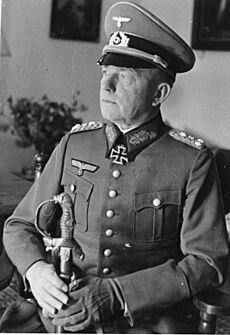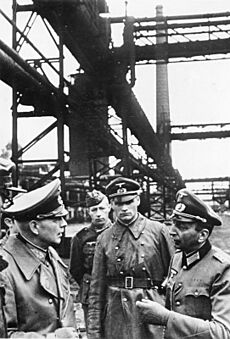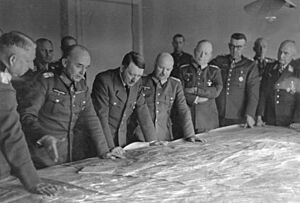Paul Ludwig Ewald von Kleist facts for kids
Quick facts for kids
Ewald von Kleist
|
|
|---|---|
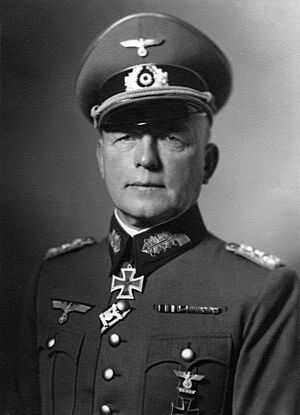
Ewald von Kleist in 1940
|
|
| Birth name | Paul Ludwig Ewald von Kleist |
| Born | 8 August 1881 Braunfels, Kingdom of Prussia, German Empire |
| Died | 13 November 1954 (aged 73) Vladimir Central Prison, Vladimir, Soviet Union |
| Allegiance | |
| Service/ |
|
| Years of service | 1900–1944 |
| Rank | Generalfeldmarschall |
| Commands held | XXII Motorised Corps Panzer Group Kleist 1st Panzer Army Army Group A |
| Battles/wars |
|
| Awards | Knight's Cross of the Iron Cross with Oak Leaves and Swords |
| Relations | Ewald von Kleist-Schmenzin (cousin) |
| Signature |  |
| War crimes | |
| Conviction(s) | War crimes |
| Criminal penalty | 15 years (Yugoslavia) 25 years (Soviet Union) |
Paul Ludwig Ewald von Kleist (born August 8, 1881 – died November 13, 1954) was a German Generalfeldmarschall (a very high-ranking general, like a Field Marshal) in the Wehrmacht during World War II. He came from a noble family in Prussia. Kleist joined the Prussian Army in 1900 and led a cavalry group during World War I. After the war, he joined the Reichswehr, which was Germany's army between the two World Wars. He left the army in 1938.
When World War II began, Kleist was called back to duty. He led a motorized army group during the Invasion of Poland. Later, he became the commander of Panzer Group Kleist (which became the 1st Panzer Army). This was the first time several tank (Panzer) groups worked together in the Wehrmacht. He led them during the Battle of France, the Battle of Belgium, the Invasion of Yugoslavia, and Operation Barbarossa, which was the invasion of the Soviet Union.
During the Battle of France, Kleist's units, including Heinz Guderian's tank corps, led a fast attack called "blitzkrieg" through the Ardennes forest. This move went around the strong French defenses known as the Maginot Line. His tank divisions pushed deep into France, which led to the defeat of the Allied forces. He then commanded the 1st Panzer Army as it moved far into Ukraine and the Caucasus during Operation Barbarossa.
Kleist was made commander-in-chief of Army Group A during the final days of Case Blue, which was Germany's big attack in southern Russia in 1942. He often disagreed with Adolf Hitler about how to fight. These disagreements led to his removal from command in March 1944, after Germany's defeat in Ukraine.
After the war, Kleist was sent to the Soviet Union. There, he was sentenced to 25 years in prison for actions during the war. He died in prison.
Contents
Early Military Life
Paul Ludwig Ewald von Kleist was born in Braunfels. His family, the House of Kleist, was an old noble family from Pomerania. They had a long history of serving in the military. Many members of his family had been high-ranking generals.
At 18, Kleist joined the Prussian field artillery in 1900. He became a second lieutenant in 1901. He moved up in rank and attended the important War Academy in Berlin. In 1914, he became a captain and joined a cavalry regiment.
During World War I, Kleist fought on the Eastern Front. He led a cavalry squadron in the Battle of Tannenberg. From 1915 to 1918, he worked as a staff officer on the Western Front.
Between the World Wars
After World War I ended, Kleist joined a group called the Freikorps. He took part in the wars for independence in Latvia and Estonia. In 1919, he led an attack group during the Battle of Cēsis.
Kleist joined the Reichswehr in 1920. He taught tactics at the Hanover Cavalry School from 1924 to 1928. He became a colonel in 1931 and later a major general in 1932.
Kleist believed in having a king (he was a monarchist). He did not get involved much in the politics of the Weimar Republic, which was Germany's government at the time. He openly wanted the old royal family to return to power. When the Nazis took power, the Reichswehr became the Wehrmacht. Kleist was promoted to lieutenant general in 1933.
Kleist was part of a Protestant religious group called the Order of Saint John. In 1935, he became a Knight of Justice in this Order.
In February 1938, Hitler removed some army leaders who did not support the Nazi government. Kleist was forced to retire because of his beliefs. Even so, he received a special honor, being allowed to wear the uniform of his old cavalry regiment. Kleist later said he left the army because he spoke too much about Christianity and the church, which the Nazis did not like.
World War II
When World War II started, Kleist was called back to duty. He led the XXII Motorized Corps during the Invasion of Poland. His corps broke through the Polish army's southern defenses. Kleist felt his motorized units used cavalry tactics well. His units also met Soviet units invading Poland from the east. He was impressed by their modern equipment and good behavior.
Invasion of France
In May 1940, Panzer Group Kleist was created. This was the first time several tank corps worked together in the German army. Kleist's Panzer Group, which included Heinz Guderian's tank corps, was key to the invasion of Belgium, France, and the Low Countries. On May 10, it led the German breakthrough in the Ardennes forest.
Kleist and Guderian had some disagreements about the best way to attack. Kleist wanted to attack further west, but Guderian believed his plan would be faster and more effective. Kleist agreed to Guderian's plan to avoid delays. Panzer Group Kleist quickly defeated the French defenses at Sedan. They then moved west and reached the sea, trapping many Belgian, British, and French armies. After the war, Kleist said his tank actions shortened the French campaign by many months.
Invasion of Yugoslavia
Kleist was promoted to Generaloberst (another high general rank) on July 19, 1940. He also received the Knight's Cross of the Iron Cross, a high military award. In April 1941, Panzer Group Kleist was renamed the 1st Panzer Group. It led the invasion of Yugoslavia. Kleist's units were among the first to enter Belgrade, the capital.
Invasion of the Soviet Union
In June 1941, Operation Barbarossa, the invasion of the Soviet Union, began. Kleist led the 1st Panzer Group as part of Army Group South. Their goal was to capture Moldavia and Ukraine. They had early success, moving deep into Ukraine. The 1st Panzer Group broke through Soviet defenses and defeated several Soviet armies in battles like the Battle of Brody and the Battle of Uman. During the First Battle of Kiev, Kleist's group helped surround and destroy a large part of the Soviet army. However, these battles were costly, and German forces lost many tanks.
Kleist was impressed by the Soviet army. He said their soldiers were excellent fighters and learned quickly from their defeats. He also noted that their equipment, especially their tanks like the T-34, was very good.
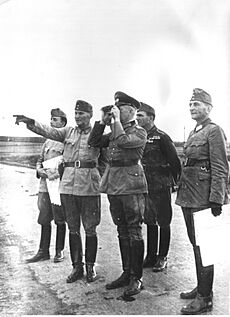
After the Kiev operations, Kleist's 1st Panzer Army moved east to capture the important industrial Donbas region. They defeated Soviet armies in the Battle of the Sea of Azov and took the Donbas. The 1st Panzer Army then attacked Rostov, a city near the Don river. They captured Rostov in November 1941. However, Soviet forces counter-attacked and forced the 1st Panzer Army to retreat from Rostov. This was the first major German retreat of the war. In February 1942, Kleist received more awards for his bravery.
In 1942, Kleist received a large estate as a gift from the Nazi government. This was part of Hitler's way of rewarding his top commanders.
Battles in Ukraine
During the Second Battle of Kharkov in May 1942, Kleist's 1st Panzer Army attacked from the south. They advanced quickly, helping to surround Soviet armies. By May 28, Kleist's and General Friedrich Paulus's armies had captured many prisoners and destroyed many Soviet tanks and artillery pieces.
Pushing into the Caucasus
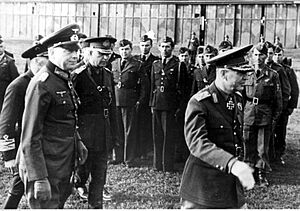
In the summer of 1942, the German Army Group South was divided. Kleist's 1st Panzer Army became part of Army Group A. Their mission was to lead the attack into the Caucasus region, aiming to capture important oil fields. Army Group A moved deep into Southern Russia, capturing cities like Rostov-on-Don and Maykop. However, strong Soviet resistance and long supply lines eventually stopped their advance. They could not reach their main goals.
In November 1942, Kleist became the commander of Army Group A. Hitler ordered him to hold his position. However, the Soviets launched major counter-attacks, surrounding the German 6th Army in Stalingrad. Kleist managed to withdraw Army Group A from the Caucasus, avoiding being cut off. Kleist later said that capturing Stalingrad was not the main goal, but rather to block Soviet attacks. He also said he tried to convince Hitler not to use Romanian, Hungarian, and Italian troops to guard the long German flank, but Hitler did not listen.
Retreat and Dismissal
On February 1, 1943, Kleist was promoted to Field Marshal. In July 1943, the Soviet army launched a huge attack along the Dnieper river. By October 1943, part of Army Group A was forced to retreat from Crimea. Kleist disagreed with Hitler's order to hold Crimea at all costs.
In November 1943, the Soviets cut off the 17th Army's land connection. By December 1943, Kleist's Army Group A had to retreat to southwest Ukraine. The Soviets launched another big attack in December 1943, aiming to take back all of Ukraine. Kleist's Army Group A faced heavy fighting and lost important mining areas. On March 11, Kleist decided to retreat his army group, even against Hitler's and Romanian leader Ion Antonescu's wishes. By the end of March 1944, the German lines in Ukraine were broken, and the Soviets had taken back most of the area.
These defeats led to heavy German losses. Kleist had disagreed with Hitler about retreating his forces to better defensive positions. Hitler blamed his generals for the Soviet successes. On March 30, 1944, Kleist was dismissed from his command and replaced.
After a failed attempt to assassinate Hitler in July 1944, Kleist was arrested by the Gestapo (Nazi secret police). This was because his cousin was involved in a plot against Hitler. Kleist was later released and avoided trial.
Working with Local People
Kleist tried to gain the support of the local people in the Caucasus and Ukraine. He believed that if Germany did not win over the local population, they would lose. He had advisors who helped him understand how to treat non-Russian ethnic groups. Because of Kleist's policies, about 800,000 Soviet citizens joined the fight against the Soviet Union. These people included different ethnic groups like Azerbaijanis, Uzbeks, Georgians, and Cossacks. Many of them served in special units. Kleist used these recruits in Cossack cavalry regiments and in other infantry divisions.
Kleist's approach was sometimes different from other Nazi officials. He reportedly clashed with officials like Fritz Sauckel, who was in charge of forced labor, and Erich Koch, who was the Nazi leader of Ukraine. Kleist once ordered his officers to make sure that people joining labor programs in his area were truly volunteering. He also told SS and police officials that he would not allow "excesses" (bad actions) in his command zone.
Trial and Death
Kleist was arrested in April 1945 by American forces and then handed over to the British. He gave testimony in the Nuremberg trials. In September 1946, he was sent to Yugoslavia. There, he was tried and sentenced to 15 years in prison for actions during the war. Kleist stated that the 1941 bombing of Belgrade was mainly for political terror and revenge, not for military reasons. He was the highest-ranking German commander to be tried in Yugoslavia.
In 1949, Kleist was sent to the Soviet Union. He was charged with actions during the war. Soviet prosecutors presented evidence that German forces, including units under Kleist's command, caused great destruction and loss of life in certain areas. Kleist was sentenced to 25 years in a correctional labour camp.
In 1952, a Soviet court declared Kleist a very dangerous criminal. He was then sent to Vladimir Central Prison.
On November 13, 1954, Kleist died in Vladimir Central Prison from heart failure. He was the highest-ranking German soldier to die in Soviet captivity. He was buried near the prison.
In October 1955, after German Chancellor Konrad Adenauer visited Moscow, the Soviet Union sent home the remaining German prisoners of war. Kleist's body was returned to Germany. Kleist had two sons, Johannes Jürgen Christoph Ewald and Hugo Edmund Christoph Heinrich.
Awards
- Iron Cross (1914) 2nd Class (October 4, 1914) & 1st Class (January 27, 1915)
- Clasp to the Iron Cross (1939) & 2nd Class (September 17, 1939) & 1st Class (September 27, 1939)
- Hanseatic Cross
- Knight's Cross of the Iron Cross with Oak Leaves and Swords
- Knight's Cross on May 15, 1940, as General der Kavallerie and commanding general of XXII. Armeekorps (Panzergruppe "von Kleist")
- Oak Leaves on February 17, 1942, as Generaloberst and Commander-in-chief of Panzergruppe 1
- Swords on March 30, 1944, as Generalfeldmarschall and Commander-in-chief Heeresgruppe A
Images for kids
See also
 In Spanish: Ewald von Kleist para niños
In Spanish: Ewald von Kleist para niños


